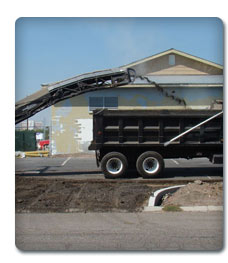Asphalt Repairs
Seamless Asphalt Repair

The Seamless Asphalt Repair uses infrared technology to reheat existing asphalt to a malleable state so that it can be reworked and reused. During the process, the reheated asphalt is loosened up, new asphalt and rejuvenating oils are added to replace what has been lost in the aging process, and then finish raked and compacted to yield a brand new surface. It only takes up to 30 minutes to give you a permanent repair. The best part is that these small repairs are very inexpensive!
Removal and Replacement of Existing Asphalt (R&R)
The deterioration of asphalt occurring as a result of lack of maintenance, overuse, or simply living past its life expectancy. In such cases, old asphalt pavement may need to be removed and replaced or refurbished with one of the following options:
- Pothole Repair
- Skin Patching
- Overlay
- Fabric Overlay
- Asphalt Grinder (Milling Machine)
- Complete Removal & Replace
- Over Excavation (OX)
Pothole Repair
Potholes occur when moisture penetrates cracks in the asphalt surface of a road or driveway. Cold weather freezes the water and causes it to expand. A pothole forms when dirt and gravel is forced out leaving a hole. The ice eventually melts and the stressed asphalt becomes a pothole. Asphalt Protectors will cut out the pothole area, clean it and use an asphalt filling appropriate for the repaired area.
Skin Patching

Skin patch patches are used to fill depressions, in which case the patch could be as thick as three or four inches. A skin patch differs from removal and replacement because existing asphalt is not removed during skin patching. This type of repair should only be used when there is no base failure, to correct drainage. Skin Patch is also used to isolate asphalt that is Spaulding (loose & rough) to extend the life of the asphalt (3-10 Yrs.).Skin patches generally use a fine sand aggregate as opposed to coarse aggregate because the edges of the patch are “feathered” out to zero thickness. Usually skin patching is used to improve the appearance of pavement or stop water penetration. Skin patches are generally 1 ½ inches or less in thickness.
Asphalt Grinder (Milling)

Utilizing a milling machine, the deteriorated asphalt is recycled by grinding it into small bits. This material is then graded and re-compacted for use as part of the base for the new pavement. This method is environmentally sound and is used whenever possible. Drainage and grade considerations help determine if this approach is a valid option.
Complete Removal and Replacement
Severe subgrade deficiencies may require complete removal of part or all of the pavement and base material. After excavation and removal, pre-existing conditions in the subgrade such as excess moisture, shallow utility lines, missing aggregate base, or incorrectly prepared subgrade may require additional steps in the base preparation. These conditions are usually not discovered until the overlying asphalt is removed. After careful inspection, your Ace Asphalt representative can recommend the most effective methods to resolve these conditions. When pre-existing conditions have been corrected, new aggregate is supplied as needed and re-compacted. The new asphalt is then placed and compacted with vibratory rollers to finish the process.
Over Excavation (OX)
Applies when the remove and replace of asphalt occurs. Once the asphalt is removed and the base is being graded, the heavy equipment or even walking will create a pumping action in the base. If the base fluctuates, these areas must be OX’d. Depending on the material make-up, over excavation can be up to two feet below the base grade. Once the unsuitable material is removed, base material is installed in increments of three-inch layers and compacted until grade is achieved. If your project may not require complete removal and replacement, consider our Asphalt Overlay service.